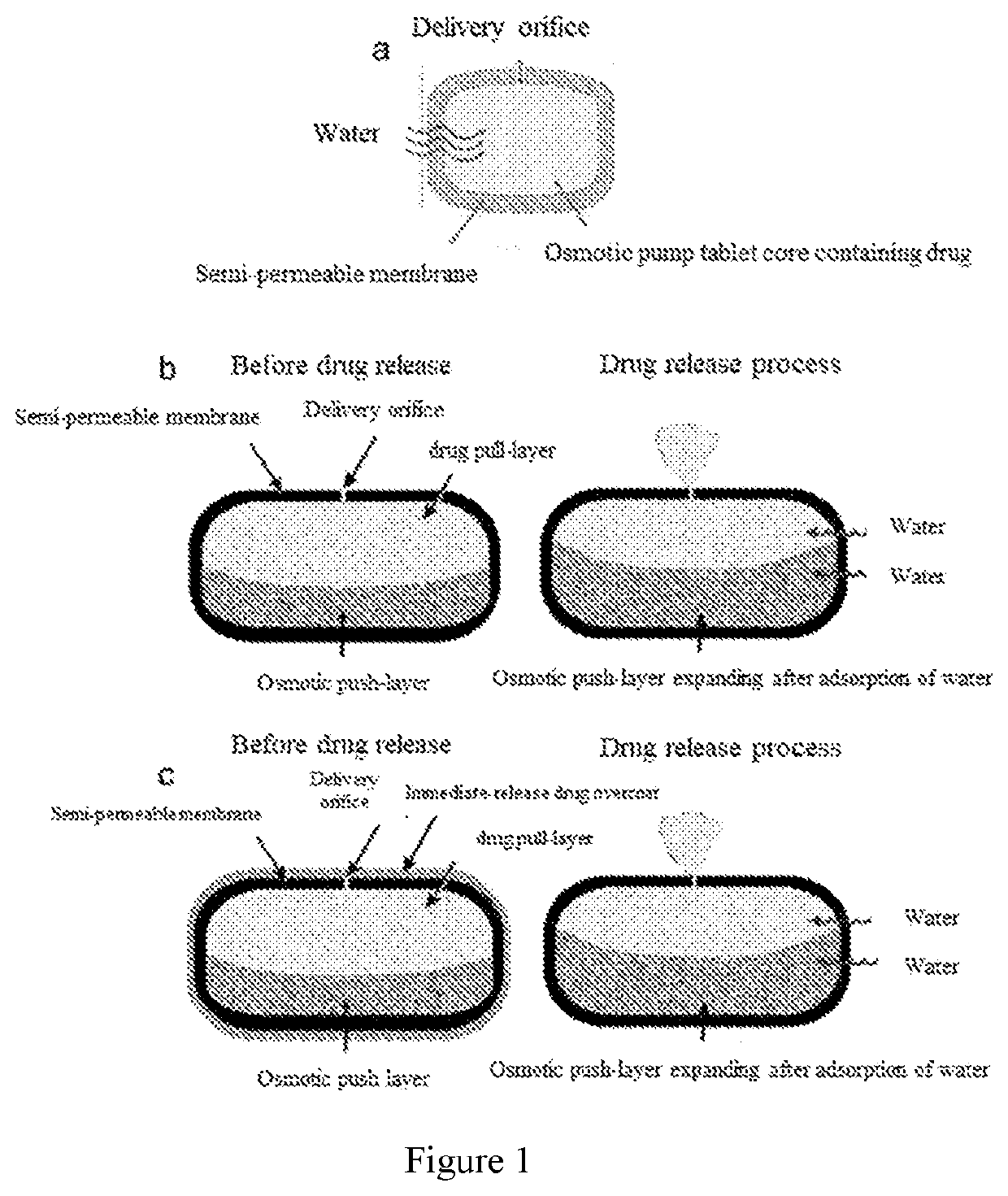Pharmaceutical composition and preparation method therefor and use thereof
a technology of pharmaceutical composition and preparation method, applied in the field of biomedicine, can solve the problems of aforementioned technologies having very limited success, unable to achieve prolonged therapeutic coverage, and aforementioned bioavailability, and achieve the effect of improving the bioavailability of a pharmaceutical composition and stable plasma profile of active pharmaceutical ingredients
- Summary
- Abstract
- Description
- Claims
- Application Information
AI Technical Summary
Benefits of technology
Problems solved by technology
Method used
Image
Examples
example 1
[0134]A dosage form for dispensing the beneficial drugs levodopa and carbidopa to oral cavity was manufactured as follows: first, a tablet core was prepared, comprising, in weight percentage, 40.0 Wt % of levodopa (LD), 10.8 Wt % of carbidopa monohydrate (CD), 20.0 Wt % of microcrystalline cellulose, 18.7 Wt % of mannitol, 5.0 Wt % of hydroxypropyl methylcellulose (HPMC E5) and 5.0 Wt % of citric acid that were each passed through a 40-mesh stainless steel sieve, then blended and granulated with pure water until homogeneous wet mass was formed; the wet mass was passed through a 20-mesh stainless steel sieve and dried at 80° C. for 2 hours; the dried granules were passed through an 18-mesh stainless steel sieve and then mixed with 0.5 Wt % of magnesium stearate.
[0135]Next, 500 mg of the drug core granules were compressed into a single-layer tablet core with a 9.0 mm round punch using a tablet press.
[0136]Next, the single-layer tablet core was coated with a semi-permeable membrane. Th...
example 2
[0137]A dosage form designed, shaped and adapted for dispensing the beneficial drugs levodopa and carbidopa monohydrate to oral cavity was manufactured as follows: first, a drug layer composition was prepared, comprising, in weight percentage, 40.0 Wt % of LD, 10.8 Wt % of CD, 31.0 Wt % of hydroxypropyl cellulose having an average molecular weight of 80,000, 12.7 Wt % of mannitol and 5.0 Wt % of citric acid, these excipients were each pass through a 40-mesh stainless steel sieve, then blended and granulated with 95% ethanol until homogeneous wet mass was formed; the wet mass was passed through a 20-mesh stainless steel sieve and dried at 80° C. for 2 hours; the dried granules were passed through a 18-mesh stainless steel sieve and then mixed with 0.5 Wt % of magnesium stearate.
[0138]Next, a second composition, the osmosis layer, was prepared, comprising 55.0 Wt % of sodium carboxymethyl cellulose 7H4XF, 39.0 Wt % of sorbitol, 5.0 Wt % of Povidone K30 and 0.5 Wt % of iron oxide red; ...
example 3
[0141]In this example, the procedures of Example 2 were repeated, and the dosage form consisted of the drug layer, osmotic layer, and coating membrane was identical to those provided in Example 2. In this example, the membrane weight gain was 4.0%, and the size of the delivery orifice varied from 0.5 mm, 0.75 mm, to 1.0 mm. The final manufactured dosage form delivered LD and CD at an average rate of 21.3 mg / hr and 5.7 mg / hr, respectively, with 85% of LD / CD delivered in 8.0 hours. As shown in FIG. 5, the size of the delivery orifice has no significant impact on the release profile. The osmotic delivery system can be kept in oral cavity until the osmotic layer reached the delivery orifice, or kept there for 4-5 hours, and then was swallowed.
PUM
| Property | Measurement | Unit |
|---|---|---|
| time | aaaaa | aaaaa |
| diameter | aaaaa | aaaaa |
| diameter | aaaaa | aaaaa |
Abstract
Description
Claims
Application Information
 Login to View More
Login to View More - R&D
- Intellectual Property
- Life Sciences
- Materials
- Tech Scout
- Unparalleled Data Quality
- Higher Quality Content
- 60% Fewer Hallucinations
Browse by: Latest US Patents, China's latest patents, Technical Efficacy Thesaurus, Application Domain, Technology Topic, Popular Technical Reports.
© 2025 PatSnap. All rights reserved.Legal|Privacy policy|Modern Slavery Act Transparency Statement|Sitemap|About US| Contact US: help@patsnap.com



